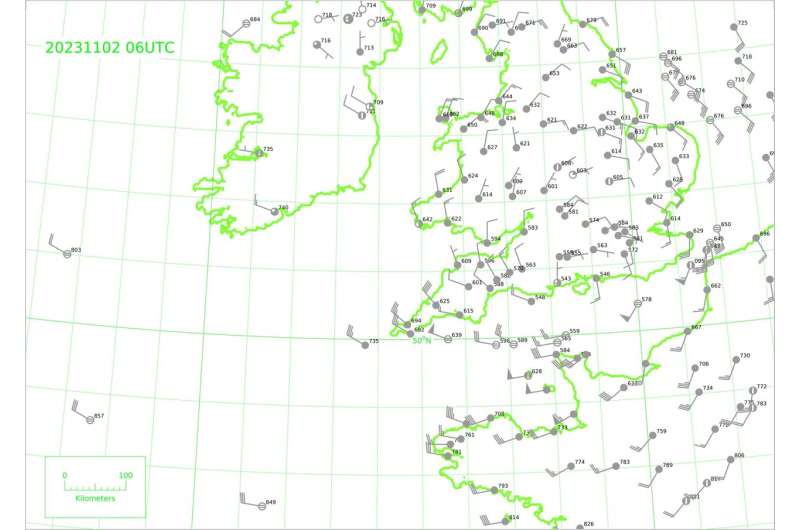This article has been reviewed according to Science X's editorial process and policies. Editors have highlighted the following attributes while ensuring the content's credibility:
fact-checked
peer-reviewed publication
trusted source
proofread
AI weather forecasts can capture destructive path of major storms, new study shows

Artificial intelligence (AI) can quickly and accurately predict the path and intensity of major storms, a new study demonstrates.
The research, based on an analysis of November 2023's Storm Ciarán, suggests weather forecasts that use machine learning can produce predictions of similar accuracy to traditional forecasts faster, cheaper, and using less computational power.
Published in npj Climate and Atmospheric Science, the University of Reading study highlights the rapid progress and transformative potential of AI in weather prediction.
Professor Andrew Charlton-Perez, who led the study, said, "AI is transforming weather forecasting before our eyes. Two years ago, modern machine learning techniques were rarely being applied to make weather forecasts. Now we have multiple models that can produce 10-day global forecasts in minutes.
"There is a great deal we can learn about AI weather forecasts by stress-testing them on extreme events like Storm Ciarán. We can identify their strengths and weaknesses and guide the development of even better AI forecasting technology to help protect people and property. This is an exciting and important time for weather forecasting."
Promise and pitfalls
To understand the effectiveness of AI-based weather models, scientists from the University of Reading compared AI and physics-based forecasts of Storm Ciarán—a deadly windstorm that hit northern and central Europe in November 2023 which claimed 16 lives in northern Europe and left more than a million homes without power in France.
The researchers used four AI models and compared their results with traditional physics-based models. The AI models, developed by tech giants like Google, Nvidia and Huawei, were able to predict the storm's rapid intensification and track 48 hours in advance. To a large extent, the forecasts were 'indistinguishable' from the performance of conventional forecasting models, the researchers said.
The AI models also accurately captured the large-scale atmospheric conditions that fueled Ciarán's explosive development, such as its position relative to the jet stream—a narrow corridor of strong high-level winds.
The machine learning technology underestimated the storm's damaging winds, however. All four AI systems underestimated Ciarán's maximum wind speeds, which in reality gusted at speeds of up to 111 knots at Pointe du Raz, Brittany. The authors were able to show that this underestimation was linked to some of the features of the storm, including the temperature contrasts near its center, that were not well predicted by the AI systems.
To better protect people from extreme weather like Storm Ciarán, the researchers say further investigation of the use of AI in weather prediction is urgently needed. Development of machine learning models could mean artificial intelligence is routinely used in weather prediction in the near future, saving forecasters time and money.
More information: Andrew J. Charlton-Perez et al, Do AI models produce better weather forecasts than physics-based models? A quantitative evaluation case study of Storm Ciarán, npj Climate and Atmospheric Science (2024). DOI: 10.1038/s41612-024-00638-w
Journal information: npj Climate and Atmospheric Science
Provided by University of Reading





















